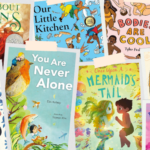
How To Prepare for Pride Month in Libraries 2024: Book Censorship News, May 10, 2024
We’re less than one month out from Pride month, and with it, the programs, book displays, and conversations to be had about LGBTQ+ identity and history across the USA and beyond. For libraries, Pride has traditionally been a month for joyful displays of queer books, with periodic and predictable complaints. But several years into surging book bans, escalating violence, and rising fascism now, it is important to prepare for the upcoming month of events to anticipate all that has, does, and might arise.
Last year, I put together a how to guide to Pride displays in libraries and it feels appropriate to repost now to help libraries prepare. If you’re not involved in libraries, let this be an opportunity to plan not only what to do when you see a Pride display in your local library, but also to take action and write your local library board about how important it is that the library offers LGBTQ+ books and centered programming.
The first Pride was a riot, and while June is and should be full of both joy and sorrow, it should be a month where queer identity and history can be experienced safely. As you prepare for displays and programs, take a few minutes to catch up with the sorts of things that came up last year during Pride at libraries — the good, the bad, and the ugly. Intimidation is a common thread, as is the intentional removal of queer books from shelves and displays thanks to initiatives like “Hide the Pride” (which will very likely enter its third annual “celebration” this year).
LGBTQ+ books and content are the most likely to be deemed inappropriate for children by parents — sometimes in numbers that are difficult to comprehend. Use the information in the research to help inform materials included in Pride displays and programming.
Equally important to the above and below is this: your staff includes queer people, even if they might not be openly out in the workplace. The more time and thought put into preparing for June, the more safety you create for them, too, and the more it becomes clear that the library truly aims to meet the needs of all and is indeed a place of democracy and civic engagement.
As a final tip this year, consider perusing the archives of Literary Activism/Book Censorship News and see what stories of anti-LGBTQ censorship have come up. What states or communities have threatened to shut down their entire public library over a couple of books featuring two mommies or two daddies? What queer books are being specifically targeted and why? Use this information to create thoughtful social media posts all month long. It helps those who are feeling the impact of this erasure and violence be seen and make clear to those who aren’t aware or don’t think it’s really happening that it is.
If you teach one patron about today’s reality for queer people, you’re making a significant difference.
*
It is impossible to completely safeguard against what will happen in any library when it comes to Pride displays. But, knowing about the tactics used by book banners ~parental rights activists~ and knowing where and how to advocate on behalf of LGBTQ+ books — and people — help in preparing for the best, most effective library pride displays.
Among the suggestions below, you’ll have easy-to-implement and manage ideas, alongside some that will likely need to be done more subversively. Maybe subversively isn’t the word, honestly. Perhaps a better way to phrase it is that some of these suggestions may bring direct activism into the picture in a way that has not always been common in public libraries.
But in today’s highly political library world, sitting back quietly is not an option. Be your own advocate right here and right now.
1. Take photos of your display and/or track the books being put on them
There are a lot of practical reasons for tracking what is going on a Pride display. It’s useful to see and ensure good representation of your collection and community. It’s also helpful in the wake of Hide the Pride style campaigns — if books go “missing” en masse, you’ll have recorded what all of those books had in common.
2. Use QR Codes/Images of Book Covers for Displays
Because these displays are popular, both with readers and with bigots, consider having images of the books on display printed with a QR code or tinyurl link to their catalog entry. This will let your readers request titles that might not be on display and/or can be useful if those titles go wandering. If you are in a library with little or no display space, use these as a display on the ends of your bookshelf, on a window space, or any other surface where patrons can see them.
3. Encourage Engagement
A book display is awesome because, generally, people know they’ll find books at the library. But you can make your display even more engaging in a few ways.
- Add reader’s advisory materials. This could be as simple as bookmarks or fliers with more LGBTQ+ books on them or a sign holder with a QR code to a curated list of queer books in your catalog.
- Include fliers and information for local LGBTQ+ inclusive support groups and community organizations. This might be cards for local queer-friendly churches or bakeries, for local GSA groups, etc. If the library is a community resource, help spread the word about additional resources that are welcoming and supportive in the community.
- Either of the above would be an opportunity to create a “donate to” call to action. You could have a sign reading “Want to support local LGBTQ+ youth? Scan the QR code to donate to our local chapter of PFLAG.” Whether or not you help raise money is not as vital as making it clear you have supportive spaces that you want people to know about.
- Encourage library users to provide feedback on the display and do it right at the display. I know, saying QR codes makes it sound like I’m in 2009. But a QR code to an online form or even a box with some golf pencils and paper that asks people to share their thoughts on the types of books and programs the library offers can go miles in helping you find your local supporters…and detractors.
- How about a sign saying, “Did you know you can request books for us to purchase?” with a call to action telling your patrons you’d love to expand your LGBTQ+ books and, if they want to suggest any, do so via the print/online form. If they include their name, they’ll be the first to know about the book’s arrival if purchased.
- If your library is blessed with the space, create an opportunity for patrons to make a DIY LGBTQ+ display. Have a blank space with a sign saying, “Share your favorite LGBTQ+ books here,” and invite folks to grab a favorite and put it on display. Bonus: this is some easy and fun passive programming, and if you worry about the books being checked out — a good worry, probably — offer some art supplies for folks to draw the cover of their favorite LGBTQ+ book.
- Print and share the very straightforward guide to how to fight book bans in 2024. I grant my permission, as the image already has credit information on it and will further spread the word about Literary Activism and book censorship news.
4. Track Your Stats
Remember the part about keeping tabs on what books are on display? You’ll want to look at your checkout rates on those books sometime in mid or late July and see how circulation of those titles compared to the previous months. Chances are, it’ll be higher. That right there is worth sharing with your community and with your boards and other community stakeholders. Once people know you have the books, they want to read them.
5. Be Frank About Intellectual Freedom and the Library
Even if you don’t have the physical space for it, you should connect with your patrons digitally to keep them aware of book bans — and the LGBTQ+ books under fire — across the country. Let patrons and visitors know there are incredible resources out there talking about First Amendment rights and intellectual freedom. Include a handout and/or link on your website/social media to sources such as: Get Ready Stay Ready, PEN America’s report on the state of book bans in America, EveryLibrary, Penguin Random House’s Book Ban Resource Hub, and our own Literary Activism newsletter.
If you have a local group doing anti-censorship work, highlight them. If you don’t, share resources on how to begin an anti-censorship group.
Include information about local elections and why they matter (and if you’re in a school or library, you can tie that neatly into how your institution is taxpayer-funded and taxpayers have the right to elect individuals who work on behalf of a whole community, not just those with close ties to them). You can also include information about local school boards and why they’re vital, as well as information about how people can get involved in their library board.
6. Be Prepared for a Challenge — and Be Transparent About Patron Rights
Be prepared to potentially have a book challenged. In the current book banning climate, it’s possible your display will become a target to the small number of censors who think they speak on behalf of an entire community. But know, too, you can head it off by making sure your collection development policies are up-to-date, and you can stand behind them. The more accessible the information, the more transparent you are, and the more censors cannot argue that you hinder their rights to demand books not be accessible to an entire community.
If there is currently a book ban happening locally, highlight that. Whether it is your institution or not, giving these displays a local angle is extremely important. Believing this is a red state or blue state thing is dangerous and disingenuous; people deserve to know that it is happening in their backyard because it IS happening in their backyard.
7. Do No Display At All and Explain Why
It might not be legal to highlight queer books in your state or community. It might be PERFECTLY legal and even encouraged.
But imagine for a moment what a book display draped in a black sheet might look like with a sign as simple as “these books are illegal to share.”
There are a lot of implications to this, including that those who are already suppressed continue to be suppressed and that this silencing plays right into it. But also know it might be extremely effective — what happens if, during Pride month, every queer book in the library is put behind the desk or popped into storage, and people cannot access them?
This is the reality in far too many places.
If you go this route, keep the focus on the people and not the books. This is where creating handouts and accompanying material to educate patrons about censorship and intellectual freedom can do wonders. The people we need to reach are not online and may likely have no idea what’s happening across the country or in their own backyard.
But perhaps this can be one step in educating and waking them up.
Again: proceed with caution here. You’ll know if it’s right for your community or not. It’ll make a hell of a statement, and if it makes people mad, maybe they’ll be ready to write those letters and show up to the board meetings, demanding those books be put back, be made accessible, and that queer voices deserve just as much space as every other voice — June and beyond.
Another take on this idea might be wrapping the books in brown paper bags or putting them into ziplock bags that create one extra step of annoyance to your patrons who want to borrow the titles. There’s your opportunity to talk about what book bans do.
Some additional resources for library Pride displays you might find useful include this guide to what to do when you see Pride displays in libraries (perfect for sharing on your library’s social media, as this is patron-facing) and recent stories of the fight for and over Pride displays in public libraries.
Book Censorship News: May 10, 2024
- The Larsen-Sant Public Library in Idaho is closing temporarily because of the new law that allows parents to sue public libraries for having materials they are bigoted toward in age-appropriate areas. The library needs to move LGBTQ+ YA to adult.
- Idaho’s new “move the books parents complain about or get sued, librarians!” law is, shocker, hard for libraries to interpret and figure out how to implement before the July 1 deadline.
- 60 books have been “temporarily removed” — that’s called banned — in Prattville Public Library (AL). The book banning happy board is getting everything their way after forcing out their director.
- Six books were challenged in the Transylvania County Schools’ libraries (PA) by the local Moms For Liberty chapter president. Five of the six have been reviewed so far, and all will remain on shelves. Most have queer characters, of course.
- Hernando County Schools (FL) will decide the fates of 23 challenged books this week. The agenda packet here is 507 pages long, with the “proof” of why these “naughty” books need to be banned, per book crisis actors. The update on this one isn’t great — 20 of the books will be permanently banned.
- How “Two Moms and Some Books,” a right-wing group of anti-library “activists” in Montgomery County, Texas, has been creating hell for local public librarians. I thought y’all said it wasn’t about the public libraries?
- Red Hood will remain on shelves in Ketchikan High School (AK).
- In more good news — I’m sandwiching it here among the not good — Let’s Talk About It will remain on shelves at North Hunterdon-Voorhees High School (NJ).
- This story is paywalled (sigh) but here are the books actually being returned to shelves in Fort Worth Independent School District (TX). Recall they’ve been off shelves for NINE MONTHS at this point. Here’s the unpaywalled list.
- A North Carolina school board member who loves banning books as part of her “work” aims her next target at “Battle of the Books,” a nationwide program to encourage reading. She thinks the program encourages activism and needs to be altered. Y’all need to be paying attention to this because it’ll be among the next waves of book targets.
- A little editorial from a pro-book banning — sorry, “move the books I disagree with somewhere else” — voice led me down a rabbit hole. What the hell has been happening in Chetco Public Library (OR)? Here’s a story from the end of 2023, but this looks like it’s been going on since mid-2022…and is STILL ongoing.
- I’ve covered quite a bit of this story already, but it’s nice to see even more details and to see it come from a site like this: here’s who is behind the push to kill Scholastic book fairs in schools.
- Current head of the Arkansas State Library Board is excited to continue dismantling the public libraries across the state.
- The reality of book bans and their impact on the Asian American community.
- Stratford, Connecticut, might eliminate school librarians with their budget challenges. This goes into any book censorship news roundup because it showcases how much value districts place on the humans helping students not only find and enjoy books, but teach them information literacy. So there’s that.
- Cy-Fair Independent School District (TX), one of the largest in the Houston suburbs, will also be eliminating librarians amid budget issues.
- Also at Cy-Fair? The school board is editing chapters of textbooks that they don’t like, including those on vaccines and diversity. Get rid of the librarians who ensure information literacy, and you can edit information to fit whatever narrative you prefer. This is the world today’s kids are growing up in if you’re wondering why they’re so unhappy. It’s not the cell phones.
- In Garfield County, Colorado, the county commissioners decided to take on the role of library board appointments and as you might expect, that’s not a good thing!
- Laramie County School District No. 1 (WY) is fixing to implement the strictest book policies in the state, banning any “sexually explicit content” from the district classrooms and libraries. As you’ll guess, what “sexually explicit content” means is up to interpretation.
- The Rockingham County Schools (VA) new policies for determining whether or not to ban books — they’ve currently got 57 pulled “temporarily” for review — are doing a good job keeping educational professionals out of the process.
- All New Orleans Public Library (LA) cardholders who have children need to re-register their kids for new cards because of the new law in the state demanding an option for parents to withdraw access to parts of the collection. This is going to hurt the poorest kids who don’t likely have parents or guardians who can easily get to the library and re-up their cards. We know that’s the whole plan.
- This isn’t the first time we’ve seen Australia engage in similarly bigoted book banning as the U.S., but here’s a story from Sydney this week about the banning of books about same-sex parenting.
- The mess that is the Warwick School District (PA) and their book banning and right-wing law center connections continues.
- An absolute must-read from one of the best writers covering extremism right now about the new religious right group firmly targeting school board seats.
Also In This Story Stream
- What Do Book Challenge Forms Look Like?: Book Censorship News, May 17, 2024
- Are Librarians Criminals? These Bills Would Make Them So: Book Censorship News, May 3, 2024
- How to Fight Book Bans in 2024: Book Censorship News, April 26, 2024
- Google Is Destroying Your Access to News: Book Censorship News, April 19, 2024
- What Young People Can Do About Book Bans: Book Censorship News, April 12, 2024
- Sexual Assault Awareness Month & Book Banning: Book Censorship News, April 5, 2024
- How Public Libraries Are Targeted Right Now—It’s Not “Just” Books: Book Censorship News, March 29, 2024
- The 2024 Lambda Literary Awards Shortlists Are Here
- You’re Wrong About These Common Myths About Book Ban: Book Censorship News, March 22, 2024







